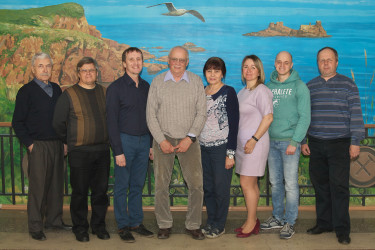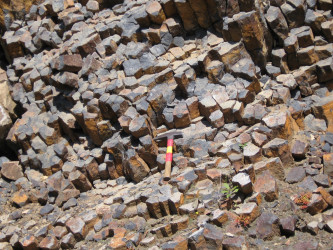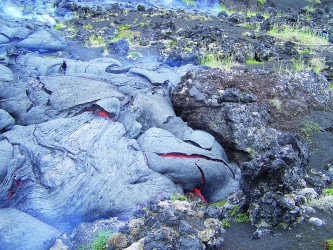Laboratory of Geochemistry
Head of the Laboratory, Prof. Yury A. MARTYNOV
Tel. +7-914-7051-867
E-mail: This email address is being protected from spambots. You need JavaScript enabled to view it.
 |
The Institute’s Department of Geochemistry was created in 1959 and comprised three laboratories – the Laboratory of Geochemistry of Volcanic Belts (headed by F.G. Fedchin), the Laboratory of Geochemistry of Sedimentary Formations (headed by M.A. Mikhaylov) and the Laboratory of Regional Geochemistry – under the direction of I.N. Govorov – founder of the geochemical method in the Far East. Such classical monographs as “Geochemistry of the Ore Districts of Primorye” and “Petrologic provinces of the Pacific Ocean” written under his supervision are still in demand as well as the geochemical data of basalts on the informative map at a scale of 1: 20 000 000.
When in the late 1980-s the Institute was reorganized, the Department of Geochemistry’s functions passed on to the Laboratory of Geochemistry headed by Candidate of Geological and Mineralogical Sciences G.B. Levashov. His works on the geochemistry of elements in magmatites of the continent–ocean transition zone are characterized by innovations in the geochemical data processing, and geodynamic interpretation. He was the one to conclude that the Sikhote-Alin’s continental crust is accretionary-collisional by nature. A collection of zircons for the isotopic dating was assembled. Since 1996, once the laboratory was combined with the Sector of Ecological Research, up to the present the Laboratory of Geochemistry has been headed by Doctor of Geological and Mineralogical Sciences Yu.A. Martynov. Currently it employs 10 workers comprising 2 Doctors and 4 Candidates of Geological and Mineralogical Sciences.
Major research directions:
- Study of the asthenospheric diapirism in the tectonic settings of convergent boundaries of the northwestern Pacific;
- Identification of strategic metals’ deposits of the Pacific Russia, their formation environment and prediction of their new and uncommon types.
 |
 |
The laboratory works closely with other academic and departmental institutes (VSEGEI, IMGG FEB RAS, IVS FEB RAS, ITG FEB RAS, Vinogradov Institute of Geochemistry SB RAS, IEC SB RAS). The up-to-date analytical equipment allowed FEGI FEB RAS to take the geochemical research to a new level, to solve genetic issues, to reconstruct geodynamic conditions. The laboratory received new geological and isotopic-geochemical data on the East Sikhote-Alin volanic belt, indicating that its formation was significantly impacted by the asthenospheric diapirism. It was revealed that only the Late Cretaceous intermediate and silicic effusive rocks rich in LILE and lacking of HFSE, formed in the supra-subduction zone setting. In the Cenozoic the shift in the parameters of interaction between the Pacific and Eurasian plates led to the subduction cessation, slab’s destruction and intrusion of the Pacific Ocean’s asthenosphere into the subcontinental lithosphere. In the Eocene-early Miocene the zone of the oceanic astenosphere influence displaced to the East, to the area of deep trenches of the Sea of Japan. The laboratory conducted the first detailed mineralogical and isotopic-geochemical research of the oldest volcanogenic formations of the northern Sikhote-Alin represented by magnesian adakites and Nb-enriched basalts with the low lead (Δ8/4Рb = 30–46) and high neodymium (0.51279–0.51281) isotope ratios, suggesting their formation took place under the descending slab’s high permeability and “hot” oceanic asthenosphere intrusion into the supra-subduction mantle. We concluded that lateral zonality of the East Sikhote-Alin volanic belt was formed on the early stages of its development as a result of a specific configuration of the Late Cretaceous continental boundary. The first results of mineralogical, geochemical and U-Pb geochronological study of volcanics of the andesite stratum situated in the central Primorye were obtained. It was uncovered that the stratum was not formed in the Paleocene, as previously thought, but in the Campanian age of the Upper Cretaceous (76.8 ± 0.56 Ma, MSWD = 1.18). The precision data on the microelemental composition indicate the predominance of the “classical” adakites with high content of Na2O, Sr, LREE, and low content of Y, HREE, and also high (La/Yb)n (12–23) and Sr/Y (45–104) ratios. The study of metalliferous coal deposits of the East Asia (in the Russian Primorye and South China) revealed a complex interaction between the continental crust and mantle under the influence of plumes and/or the ascending asthenospheric flows which played a significant role in the formation of the volcanogenic structures that controlled the coal basins and ore-bearing thermal systems. These processes accounted for the birth of the rare metal [Zr(Hf)–Nb(Ta)–REE and U(Mo, Se)–REE] occurrences not only in coals but also in the coal-bearing rocks; As part of the scientific cooperation with the Laboratory of Nanomineralogy of IGNM FEB RAS (headed by Academician V.G. Moiseenko; city of Blagoveschensk), the joint research on the chemical composition of native gold of the worked-out placers of the Nizhneselemdzhinsky gold-bearing cluster in Priamurye was carried out. It was established that most gold has heterogeneous composition due to the presence of different phases including the amalgams that vary the composition. The gold individuals, except the phases of 1000‰ fineness and solid solutions of gold with silver, contain multiple phases of amalgams that are two-, three- and four-component solid solutions of gold with Hg, Pb and Ag. When developing new technologies for the full extraction of the noble metal from technogenic placers, it is recommended to consider that the gold contained therein usually has a complex multiphase and multicomponent composition. The laboratory’s international scientific activity includes the study of modern subduction magmatism processes together with the Japanese colleagues as well as the work within the Agreement on cooperation between FEGI FEB RAS and the National Museum of Nature and Science, Tsukuba, Japan, aimed at reconstructing the conditions of methane manifestation and its siliceous compounds in the south of Sakhalin Island. Under the Agreement with the State Key Laboratory of Coal Resources and Safe Mining of the China University of Mining and Technology (Beijing) we conduct research on the subject of “Mineralogy, geochemistry and petrology of coal deposits”.
![Examples of direct and reverse zoning. Photographs of direct and reverse zoned clinopyroxene crystals (A) [sample Ча-2605], and reverse zoned clinopyroxene with rhythmic zoned plagioclase crystals (B) [sample 4170615] in andesites of the Talminsk strata. Photographs in the reflected electrons were made with the use of microanalyzer JEOL JXA-8100 in the Laboratory of X-Ray Methods of FEGI FEB RAS](/images/thumbnails/images/lab/geochemistry/foto3-fit-650x250.png) |

